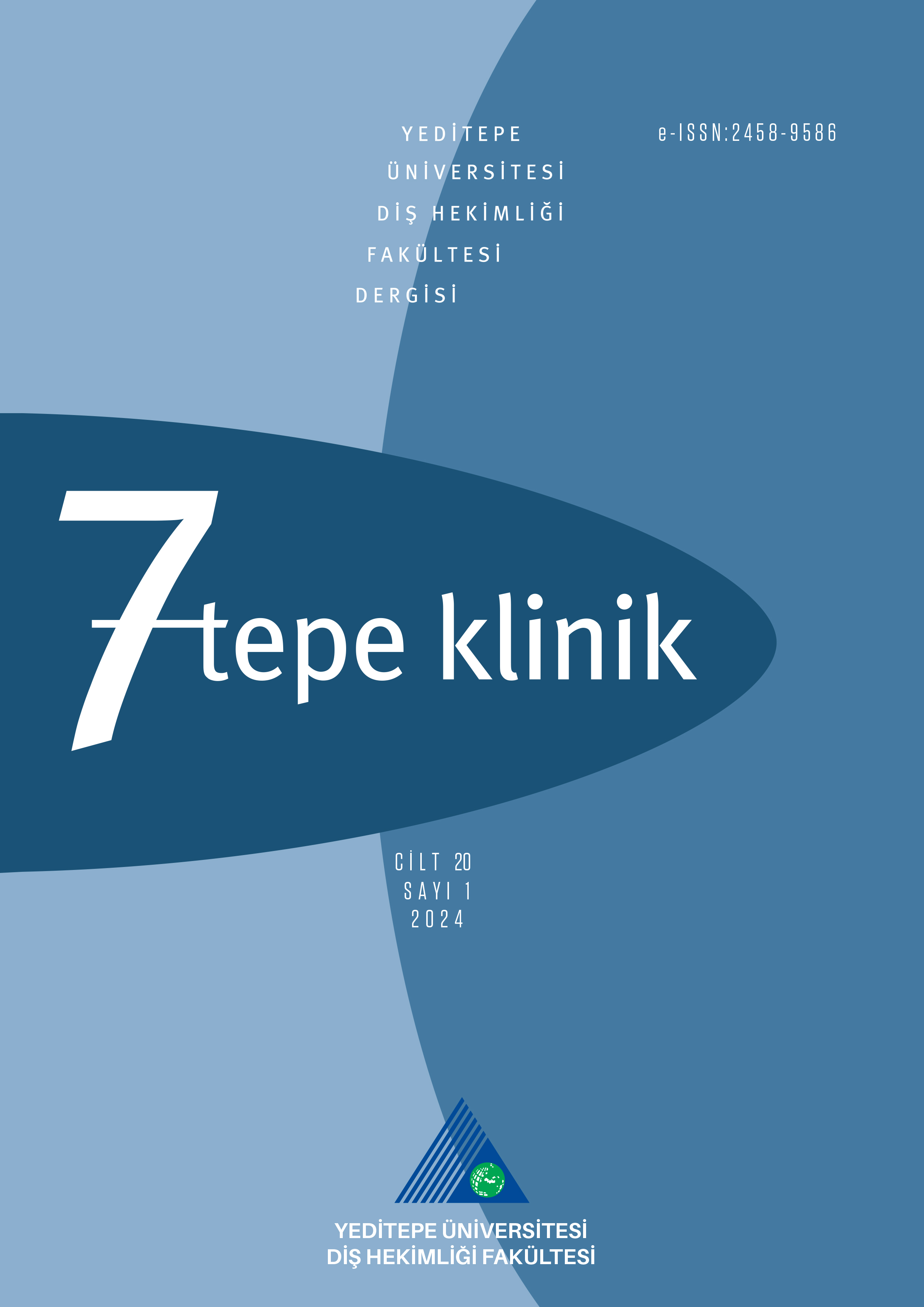Parsiyel dişsizlik ve tedavi seçenekleri
Zeynep Özkurt Kayahan1, Ceyda Özçakır Tomruk2, Ender Kazazoğlu11Yeditepe Üniversitesi, Diş Hekimliği Fakültesi, Protetik Diş Tedavisi Anabilim Dalı, İstanbul2Yeditepe Üniversitesi, Diş Hekimliği Fakültesi, Ağız, Diş ve Çene Cerrahisi Anabilim Dalı, İstanbul
GİRİŞ ve AMAÇ: Bu çalışmanın amacı, farklı kısmi dişsizlik tiplerinin belirlenmesi ve bu dişsizliklerin protetik tedavi seçeneklerinin incelenmesidir.
YÖNTEM ve GEREÇLER: Yeditepe Üniversitesi Dişhekimliği Fakültesi Protetik Diş Tedavisi Anabilim Dalında, dijital kayıt sistemi incelenerek retrospektif bir değerlendirme yapıldı.
Hastalar kayıt sisteminden randomize olarak seçildi ve çalışmaya şu kriterlere göre dahil edildi; en az bir çenesinde kısmi dişsizliğe sahip olmak, panoramik radyografi çektirmiş olmak, protetik tedavisi tamamlanmış ya da tedavi yaptırmadan ayrılmış olmak. Hastaların yaşı, cinsiyeti, kısmi dişsizlik (Kennedy) sınıflaması ve tedavi seçenekleri kaydedildi. Elde edilen verilerin istatistiksel analizinde tanımlayıcı yöntemler ve Ki-Kare testi kullanıldı. Anlamlılık p< 0,05 düzeyinde değerlendirildi.
BULGULAR: Çalışmaya yaş ortalaması 50,88 ± 14,09 olan 345 hasta (147 erkek, 198 kadın) dahil edildi. Kennedy III dişsizliğin, üst çenede (%71,1) ve alt çenede (%55,9) en sık görülen dişsizlik tipi olduğu belirlendi. Kısmi dişsizliğin üst çenede (%57,9) ve alt çenede (%41,7) sıklıkla sabit protezlerle tedavi edildiği gözlendi. Hastaların yalnızca %13-14'üne implant tedavisi uygulandı.
TARTIŞMA ve SONUÇ: Dental implantlar, kısmi dişsizlikte en az tercih edilen tedavi seçeneğiydi. Sabit protezler Kennedy III ve IV için en yaygın tedavi yöntemi iken, hareketli bölümlü protezler Kennedy I ve II için en yaygın tedavi seçeneğiydi.
Partial edentulism and treatment options
Zeynep Özkurt Kayahan1, Ceyda Özçakır Tomruk2, Ender Kazazoğlu11Yeditepe University, Faculty of Dentistry, Department of Prosthodontics, Istanbul, Turkey.2Yeditepe University, Faculty of Dentistry, Department of Oral and Maxillofacial Surgery, İstanbul
INTRODUCTION: The purpose of this study was to determine the prevalence of various types of partial edentulism, and type of prosthetic restorations most commonly chosen to treat the patients.
METHODS: A retrospective evaluation was conducted in Department of Prosthodontics, Dental School of Yeditepe, Turkey, by examining the digital record system of the faculty. The patients were selected randomized and the inclusion criteria were; patients who had partial edentulism at least on their one jaw, who had panoramic radiographs, whose treatment had been finished, and who had no treatment. Age, gender, Kennedy classification and treatment options were recorded. Descriptive statistical methods and Chi-square test were used to analyze data. An alpha level of 0.05 was used for all statistical analyses.
RESULTS: There were 345 patients (147 males, 198 females) with the mean age of 50.88±14.09 years. Kennedy III was the most common in the maxilla (71.1%) and in the mandible (55.9%). Partial edentulism was most frequently managed by fixed partial dentures in the maxilla (57.9%) and in the mandible (41.7%). Implant treatment was applied to 13-14% of the patients.
DISCUSSION AND CONCLUSION: Dental implants were the least common treatment option for partial edentulism. Fixed partial dentures were the most common treatment for Kennedy III and IV, whereas removable partial dentures were the most common for Kennedy I and II.
Sorumlu Yazar: Zeynep Özkurt Kayahan, Türkiye
Makale Dili: İngilizce



